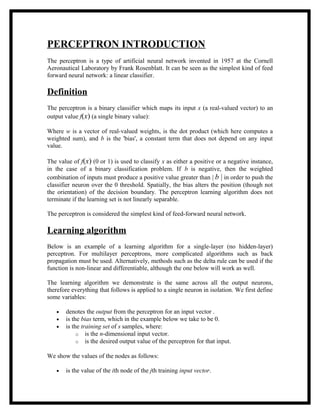
Perceptron working
- 1. PERCEPTRON INTRODUCTION The perceptron is a type of artificial neural network invented in 1957 at the Cornell Aeronautical Laboratory by Frank Rosenblatt. It can be seen as the simplest kind of feed forward neural network: a linear classifier. Definition The perceptron is a binary classifier which maps its input x (a real-valued vector) to an output value f(x) (a single binary value): Where w is a vector of real-valued weights, is the dot product (which here computes a weighted sum), and b is the 'bias', a constant term that does not depend on any input value. The value of f(x) (0 or 1) is used to classify x as either a positive or a negative instance, in the case of a binary classification problem. If b is negative, then the weighted combination of inputs must produce a positive value greater than | b | in order to push the classifier neuron over the 0 threshold. Spatially, the bias alters the position (though not the orientation) of the decision boundary. The perceptron learning algorithm does not terminate if the learning set is not linearly separable. The perceptron is considered the simplest kind of feed-forward neural network. Learning algorithm Below is an example of a learning algorithm for a single-layer (no hidden-layer) perceptron. For multilayer perceptrons, more complicated algorithms such as back propagation must be used. Alternatively, methods such as the delta rule can be used if the function is non-linear and differentiable, although the one below will work as well. The learning algorithm we demonstrate is the same across all the output neurons, therefore everything that follows is applied to a single neuron in isolation. We first define some variables: • denotes the output from the perceptron for an input vector . • is the bias term, which in the example below we take to be 0. • is the training set of s samples, where: o is the n-dimensional input vector. o is the desired output value of the perceptron for that input. We show the values of the nodes as follows: • is the value of the ith node of the jth training input vector.
